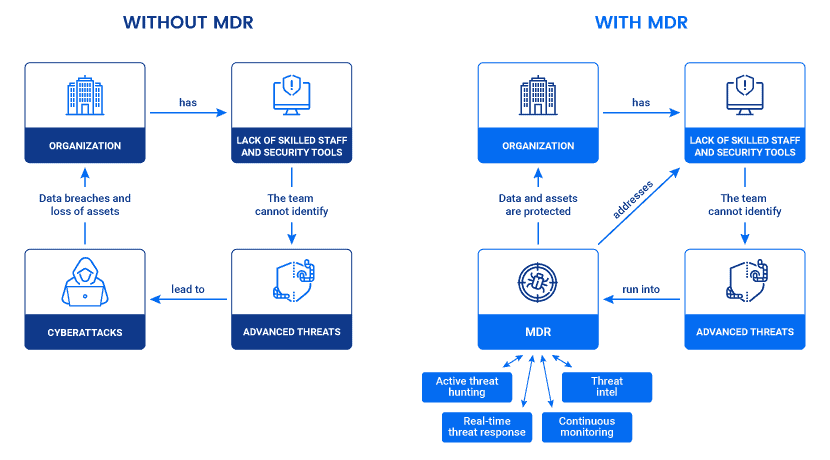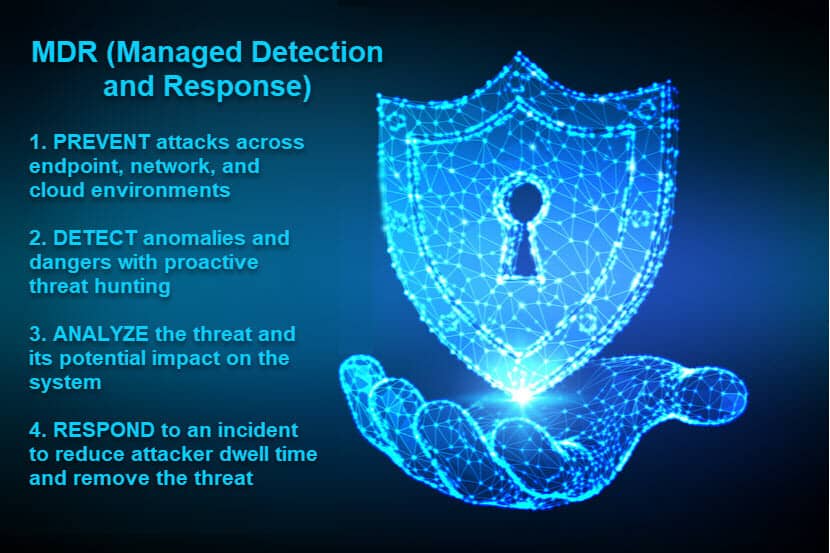Maintaining high levels of cybersecurity is expensive. To run security operations, companies must invest in skilled staff and set aside resources for the right tools and devices.
Managed Detection and Response (MDR) services are a cost-effective alternative to running an in-house security team.
This article provides everything you need to know about MDR security. Learn how Managed Detection and Response provides real-time protection without the expenses of a fully-staffed internal team.
What is Managed Detection and Response in Cybersecurity?
Managed Detection and Response (MDR) is an outsourced service that monitors a network for malicious activity. MDR offers proactive threat hunting to remove intrusions, data breaches, and malware before an attacker can strike.
It combines analytics and human expertise to detect and eliminate threats in the network. The standard scope of MDR security includes:
- Threat detection: Constant monitoring of data and filtering alerts for analysis.
- Threat analysis: Examining a potential threat to discover its origin, scope, and risk level.
- Incident response: Notifying the client about the issue and removing the threat.
While less expensive than an internal team, MDR provides everything needed to keep a network secure:
- 24/7 monitoring
- Careful alert and incident analysis
- Quick and efficient threat response
- Threat hunting
- Strong threat intelligence
- Damage reduction from successful attacks and breaches
The service provider configures and provides the tools needed for MDR. Once set up, MDR tools analyze event logs and guard gateways to detect threats that evade typical security levels.
phoenixNAP implemented multiple security layers, including MDR, to design the world's safest Cloud computing platform - Data Security Cloud.
Developed in collaboration with VMware and Intel, Data Security Cloud is a cloud infrastructure platform that leverages the latest MDR practices to ensure advanced data protection, vulnerability scanning, and endpoint protection.
While tools play a significant role, Managed Detection and Response primarily relies on humans for network monitoring. Tools filter event logs and detect potential Indicators of Compromise (IoC). Once a threat is recognized, human operators take over and remove the danger.
What is Threat Hunting in Cybersecurity?
Threat hunting in cybersecurity is a proactive approach to detecting, isolating, and removing threats. The main goal of threat hunting is to find malicious elements that evade automated security solutions.
Cyber threat hunting focuses on searching and eliminating threats before the attack occurs. This security measure does not involve addressing incidents that already took place.
Once malicious elements are located, threat hunters analyze the issue’s behavior and methods before neutralizing it. Threat hunting also involves identifying trends in attacks to prevent future breaches.
Threat hunting relies on human analysts. Tools speed up processes and repetitive tasks, but human operators make all crucial decisions.

MDR Is Growing in Popularity
When a company expands its IT system, there is a rise in network endpoints like laptops, desktops, and mobile devices. Each new endpoint creates a potential entry point for hackers.
Between constant monitoring and threat hunting, MDR is an excellent method of protecting endpoints. The ability to quickly secure entry points is why Managed Detection and Response is popular among enterprises. Large companies regularly add new devices to their systems, so defending endpoints is a big concern.
Enterprise Strategy Group (ESG) recently surveyed employees from mid-to-large enterprises to examine critical problems related to threat detection and responses.
Below are some exciting discoveries from the ESG research:
- 77% of security experts said that managers are pressuring them to improve threat detection and response tactics.
- According to 76% of companies, security analytics is more complex than two years ago.
- 58% of businesses cited employee skills as the main problem for improving security.
- Manual processes and alert fatigue are viewed as a critical issue by 70% of companies.

Add to those numbers the lack of capable staff on the market, and it becomes easy to see why there is an increase in demand for MDR.
What Problems Does MDR Solve?
Managed Detection and Response solves several common problems security teams face:
High Alert Volume
Too many alerts can overwhelm a small security team. Alert fatigue leads to inadequate monitoring, causes workers to neglect other tasks, and leaves a network open to an attack.
Managed Detection and Response helps handle the volume of alerts that need to be checked individually. Once set up, MDR security does all the monitoring in the system, leaving the staff with ample time to focus on other duties.
Threat Analysis
It is hard to identify severe threats from alert noise. A malicious element may appear to be a random alert, while common errors can raise red flags across the system. To determine the cause, scope, and status of a problem, an IT team must analyze the situation.
By investing in MDR, a company secures advanced analytics tools and security experts capable of interpreting events in the network.
Advanced Attacks and Breaches
A poorly trained IT team can struggle when faced with an advanced threat.
MDR providers are staffed with security specialists capable of keeping up with cyberattacks. By investing in MDR security, you ensure the industry’s best talent monitors your networks and devices.
Endpoint Detection and Response (EDR)
Businesses often lack funds, time, or skills to train operators to use EDR tools properly. MDR services come with high-end EDR tools and the personnel who know how to use them. EDR tools are integrated into detection and response processes, removing the need for in-house endpoint protection.
Benefits of MDR Security
Standard tools for cybersecurity are good at stopping simple breaches and attacks. However, preventive tactics are not enough to secure an entire infrastructure.
MDR offers a thorough method of ensuring network safety. Instead of focusing solely on prevention, MDR goes after threats before they get an opportunity to cause damage.
Better Overall Approach to Security
Managed Detention and Response detects, analyzes, and stops threats, offering a comprehensive security solution.
When an MDR tool detects a problem, the team first verifies the validity of the threat. If the issue has a malicious cause, operators inform you about the situation and eliminate the threat.
Isolating the threat is another significant aspect of MDR. If a potential attack is spotted, the issue is contained within a single system. The threat is then unable to spread to other sectors of the network. That way, MDR reduces damage from successful breaches.
No False Alarms
When a standard security control runs into an alert, it sends unchecked alerts to operators. The process of separating false signals from real dangers wastes time and resources.
MDR performs an in-depth investigation of every suspicious activity in the network. Each threat is analyzed to check its status. Alerts that reach the security team require immediate action, so there are no pointless distractions.
Fast, Seamless Deployment
Setting up a custom detection and response system requires time. One would need to license software tools, set up the system, create procedures and security policies, and train the staff.
MDR solutions require little configuring and follow cybersecurity best practices.
Swift Detection of Threats
The quicker a threat is detected and dealt with, the easier and cheaper it is to remove it. Without MDR security, it takes an average of 280 days to identify and contain a breach.
Managed Detection and Response improves detection levels and reduces dwell time of breaches.
Easier Compliance
All major MDR providers ensure their defense procedures are compliant with regulatory bodies. Your MDR partner can help review processes and implement best practices.
Managed Detection and Response (MDR) vs. Managed Security Services Providers (MSSP)
While the two types of service share similarities, there are differences between MDR and MSSP regarding tools, expertise, and objectives.
Here is a comparison between what typical MDR and MSSP services include:
MDR vs. MSSP Security Services
| Managed Detection and Response | Managed Security Services Providers | |
|---|---|---|
| 24/7 threat detection | Yes | Yes |
| Firewalls and other perimeter security infrastructure | Yes | Yes |
| Proactive threat hunting | Yes | Yes |
| Threat forensics | Yes | Yes |
| Responding to attacks | Yes | Yes |
| Portals and dashboards are a primary line of communication | No | Yes |
| An on-call team of experts | Yes | Yes |
| Deep threat intelligence and analysis | Yes | No |
| Use of AI and machine learning | Yes | Yes |
| Integrated endpoint security | Yes | No |
| Compliance Checks | No | Yes |
| Vulnerability Hunting | No | Yes |
MDR security focuses on detecting and responding to potential malicious elements. MSSP is reactive and focuses on finding and eliminating vulnerabilities and compliance issues. Both types of service play a role in the modern IT landscape, and the better option entirely depends on the use case.
An MSSP system monitors network security controls and sends alerts when it detects an anomaly. It then forwards the report to the assigned IT staff, who inspects the data to analyze and remove any danger. In that regards, an MSSP secures infrastructure on more levels.
It is possible to use MSSP and MDR services at the same time. A company can rely on MSSP to run firewalls and other day-to-day operations. At the same time, MDR can detect and analyze advanced threats.
Does Artificial Intelligence (AI) Play a Role in MDR?
Applying Artificial Intelligence (AI) to security problems is still in its early stages. Now, and for the foreseeable future, the only reliable security expert is a human operator.
Managed Detection and Response can leverage AI to speed up cyber defense algorithms. For example, advanced threat detection can rely on AI to filter through network events and identify unusual activities. An analyst then reviews to check whether the system ran into a security alert or false alarm.
AI-powered security tools also ensure fast incident-response times. An MDR provider uses AI and machine learning to investigate recurring events, auto-contain threats, and initiate reactions.

Managed Detection and Response for a Secure Cloud
An increasing number of businesses are opting for MDR services. The benefits are clear: threat control, better response times, less downtime, and lower costs of cyber protection.
PhoenixNAP offers the most well-rounded MDR solution on the market as a part of our Data Security Cloud offering. Accessible to both SMBs and enterprises alike, our Data Security Cloud ensures MDR protocols protect all your cloud activities. We provide the right talent and tools to proactively hunt and stop threats, ensuring you can focus on developing your business without distractions.
To learn how we can help you secure your workloads, contact one of our specialists today.



